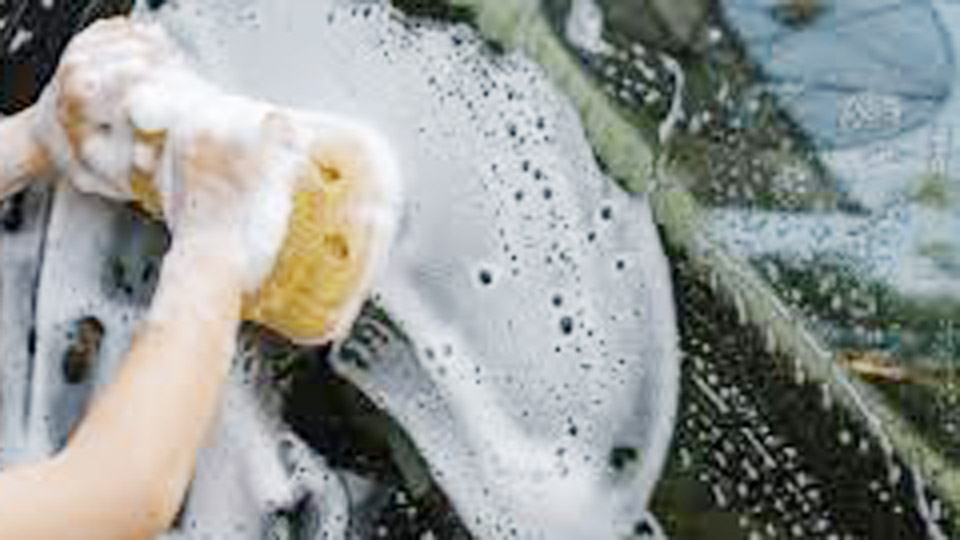Why Hand Car Washing Is the Best Choice Over Automatic Car Washing?
I’ve been a car enthusiast for as long as I can remember, spending weekends polishing my ride and keeping it spotless. I’ve tried every car washing method out there—automatic drive-throughs, touchless washes, and good old-fashioned hand washing. There’s something special about washing your car by hand, and I’m here to tell you why hand car washing is the best choice over automatic car washing.

Photo by etiqa
I’ve learned through trial and error what works and what doesn’t, and hand washing always comes out on top for keeping my car looking showroom-ready. Let’s dive into why hand washing is worth the effort, how it compares to automatic methods, and the tips I’ve picked up to make it easy and effective.
Appeal of a Clean Car
A clean car isn’t just about looks—it’s about pride. I feel a rush every time I step back and see my car gleaming in the driveway. Whether it’s a daily driver or a weekend cruiser, a clean car turns heads and holds its value. But not all washing methods are equal. Automatic car washes are fast and convenient, but they often leave much to be desired.
I’ve had swirls and scratches from automatic brushes, and touchless washes sometimes miss stubborn dirt. Hand washing, though, gives me control over every inch of my car, ensuring it gets the care it deserves.
What Is Hand Car Washing?
Hand car washing is exactly what it sounds like—you clean your car with your hands, using buckets, sponges, and microfiber cloths. I do it in my driveway with a hose, soap, and a few tools. It’s a hands-on process that lets you scrub every nook and cranny, from the wheels to the roof.
Unlike automatic washes, which rely on machines, hand washing is all about precision and care. I’ve spent hours perfecting my technique, and it’s satisfying to see the results.
What Is Automatic Car Washing?
Automatic car washing uses machines to clean your car. There are two main types: brush washes and touchless washes. Brush washes use spinning brushes or cloth strips to scrub the car as it moves through a tunnel.
I’ve used these at gas stations when I’m in a rush. Touchless washes use high-pressure water and chemicals instead of brushes. Both are quick, taking just 5-10 minutes, but they come with trade-offs. I’ve noticed they don’t always get the job done, especially for tough grime or delicate paint.
Why Hand Car Washing Wins
I’ve compared both methods side-by-side, and hand washing always comes out ahead. Here’s why I believe it’s the best choice:
Better Cleaning Results
Hand washing lets you focus on every detail. I can spend extra time on bug splatter, tar, or tree sap that automatic washes often miss. With a sponge or mitt, I control the pressure, ensuring I don’t miss a spot. I once ran my car through an automatic wash, and the wheels still had brake dust.
Hand washing gets those areas sparkling clean. You can also use specialized cleaners for different parts, like glass or chrome, which machines can’t do.
Gentler on Your Car’s Paint
Automatic washes can be rough. I’ve seen brush washes leave swirl marks on my car’s clear coat—tiny scratches that dull the shine. Touchless washes avoid this but rely on harsh chemicals that can strip wax.
Hand washing, done right, is gentle. I use microfiber mitts and plenty of soap to avoid scratches. My car’s paint stays smooth and glossy, and I don’t worry about damage from abrasive brushes.
Cost-Effective Over Time
Automatic washes seem cheap at $5-$15 a pop, but they add up. I was spending $50 a month on drive-through washes. Hand washing costs less once you have the supplies. A good bucket, soap, and mitts cost about $30-$50 upfront, and they last for years. I save money and get better results. Plus, I enjoy the process—it’s like therapy!
Customizable for Your Car
Every car is different. My SUV needs extra attention on the hood for bug splatter, while my sedan’s wheels need heavy-duty cleaner. Hand washing lets me tailor the process. I can use a clay bar for contaminants or a special polish for scratches.
Automatic washes offer one-size-fits-all cleaning, which doesn’t work for unique needs. I love knowing my car gets exactly what it needs.
Eco-Friendly Option
I care about the environment, and hand washing is greener. Automatic washes use tons of water—up to 60 gallons per wash. At home, I use about 10-20 gallons with a shut-off nozzle. I also choose biodegradable soaps, like Meguiar’s or Chemical Guys, to reduce runoff harm. Touchless washes rely on strong chemicals that can pollute waterways. Hand washing lets me control the impact.
How to Hand Wash Your Car Like a Pro
I’ve perfected my hand washing routine over the years. It’s simple, effective, and keeps my car looking amazing. Here’s my step-by-step process:
Gather Your Supplies
Before you start, get the right tools. I’ve made the mistake of using dish soap or old rags—big no-nos! Here’s what you need:
- Two buckets with grit guards: One for soap, one for rinsing. Grit guards trap dirt so it doesn’t scratch your car.
- Car wash soap: I use Meguiar’s Gold Class or Chemical Guys Honeydew Snow Foam.
- Microfiber wash mitts: Soft and safe for paint. I keep two for different areas.
- Hose with a shut-off nozzle: For controlled rinsing.
- Wheel cleaner and brush: For tackling brake dust and grime.
- Microfiber drying towels: To prevent water spots.
- Clay bar (optional): For removing contaminants like sap or tar.
I spent about $50 on my setup, and it’s lasted years.
Pre-Rinse the Car
Start by rinsing your car with a hose to remove loose dirt. I work from top to bottom to avoid pushing grime around. A pressure washer is great if you have one, but a hose works fine. I focus on the wheels first, as they’re usually the dirtiest.
Wash with the Two-Bucket Method
Fill one bucket with car wash soap and water, the other with plain water. I dip my mitt in the soapy water, wash a section of the car, then rinse the mitt in the plain water bucket. This keeps dirt from scratching the paint. I wash in small sections—hood, doors, roof—using gentle circular motions. The two-bucket method is a game-changer; it’s kept my car swirl-free.
Clean the Wheels and Tires
Wheels need special attention. I use a dedicated wheel cleaner and brush to scrub off brake dust. My SUV’s wheels get caked with grime, so I spend extra time here. Rinse thoroughly to avoid residue. A clean wheel makes the whole car pop.
Rinse and Dry
Rinse the car thoroughly to remove all soap. I use a steady stream from the hose, working top-down. Then, dry with microfiber towels to prevent water spots. I pat the surface gently instead of dragging the towel—it’s a trick I learned to avoid scratches.
Optional: Clay Bar and Wax
For extra shine, I use a clay bar to remove contaminants. It’s like exfoliating your car’s paint! Spray a lubricant, glide the clay over the surface, and feel it get smooth. After that, I apply a wax or sealant to protect the paint. My favorite is Turtle Wax Hybrid Solutions—it’s easy to apply and lasts months.
Comparing Hand Washing to Automatic Washing
Here’s a table I put together to show how hand washing stacks up against automatic methods:
| Aspect | Hand Washing | Automatic Brush Wash | Touchless Wash |
|---|---|---|---|
| Cleaning Quality | Excellent, thorough, customizable | Good, but misses tough spots | Decent, misses stubborn grime |
| Paint Safety | Very safe with proper tools | Risk of scratches and swirls | Safe but uses harsh chemicals |
| Cost | Low ($30-$50 upfront, minimal ongoing) | Moderate ($5-$15 per wash) | Moderate ($5-$15 per wash) |
| Time | 30-60 minutes | 5-10 minutes | 5-10 minutes |
| Eco-Friendliness | High (less water, biodegradable soaps) | Low (high water use, chemical runoff) | Low (chemical-heavy, high water use) |
| Customization | High, tailored to car’s needs | None, one-size-fits-all | None, one-size-fits-all |
This table shows why I prefer hand washing—it’s better for my car and wallet in the long run.
Common Mistakes to Avoid When Hand Washing
I’ve made plenty of blunders washing my car, so let me save you the trouble. Here are mistakes to steer clear of:
- Using dish soap: It strips wax and dries out paint. I did this once, and my car looked dull after.
- Washing in direct sunlight: Heat dries soap too fast, leaving spots. I wash in the shade or early morning.
- Using one bucket: Dirt gets trapped and scratches the paint. The two-bucket method is a must.
- Scrubbing too hard: It can cause swirls. I use light pressure and let the soap do the work.
- Skipping drying: Water spots are a pain. I always dry with microfiber towels.
How Often Should You Hand Wash Your Car?
I wash my car every two weeks, but it depends on your situation. If you drive daily or live in a dusty area, weekly washes keep grime from building up. In rainy or snowy climates, like Seattle or Chicago, you might need to wash more often to remove road salt. I also do quick rinses between full washes to keep things tidy. Waxing every 2-3 months protects the paint and makes washing easier.
Special Considerations for Different Cars
Not all cars are the same. My SUV has a matte finish, so I avoid wax and use a matte-specific cleaner. Luxury cars with delicate clear coats need gentle soaps and soft mitts. I helped a friend wash his BMW, and we used a pH-balanced soap to protect the paint. Older cars might have single-stage paint, which needs extra care to avoid fading. Always check your car’s manual for specific recommendations.
Time and Effort: Is Hand Washing Worth It?
Hand washing takes more time than an automatic wash—about 30-60 minutes for me. But I find it relaxing, like a workout for my car. The results are worth it: no scratches, a deeper clean, and a chance to bond with my ride.
If you’re short on time, automatic washes are tempting, but I’ve never gotten the same shine or satisfaction. Plus, hand washing lets me inspect my car for dings or scratches, catching issues early.
Eco-Friendly Hand Washing Tips
If you’re eco-conscious like me, hand washing can be green. Use a hose with a shut-off nozzle to save water. I switched to biodegradable soaps and cut my water use in half. Wash on grass or gravel so runoff absorbs naturally, not into storm drains. I also reuse old towels for drying to reduce waste. These small steps make a big difference.
DIY vs Professional Hand Washing
I love washing my car myself, but professional hand washing is an option. Detailers charge $50-$150, depending on the car and location. They have pro-grade tools and can tackle tough stains like tar.
I went to a detailer once for a deep clean, and it was impressive. But for regular maintenance, DIY is cheaper and just as effective with practice. I save money and enjoy the process.
Maintaining Your Car Between Washes
To keep your car looking great, I use a quick detailer spray between washes. It’s like a mini-wash, removing light dust and boosting shine. I also keep a microfiber cloth in my car for quick touch-ups, like bird droppings. Parking in a garage or under a tree helps, too—less dirt means less washing. I learned this after my car got covered in pollen one spring.
Conclusion
Hand car washing is more than a chore—it’s a labor of love. I’ve tried automatic washes, but nothing beats the shine, control, and satisfaction of washing my car by hand. It’s gentler on the paint, cheaper over time, and lets me give my car the care it deserves. From the two-bucket method to waxing for protection, hand washing transforms your car and your connection to it.
FAQs
Is hand washing really better than automatic washing?
Yes, it’s gentler and more thorough. I’ve seen automatic washes leave swirls, while hand washing gets every spot clean without damage.
How long does it take to hand wash a car?
It takes me 30-60 minutes, depending on the car’s size and dirt level. Wheels and drying take the most time, but it’s worth it.
Can I use dish soap to wash my car?
No, dish soap strips wax and dries out paint. I made that mistake once and regretted it. Use car-specific soap instead.
Do I need special tools for hand washing?
A few basics make a big difference—two buckets, microfiber mitts, and car soap. I spent $50 on supplies, and they’ve lasted years.
How often should I hand wash my car?
Every two weeks works for me. If you drive a lot or live in a dusty or salty area, weekly washes keep your car in top shape.
Is hand washing safe for all car types?
Yes, if you use the right tools. For matte or luxury finishes, I use specific soaps and avoid wax to protect the paint.

David Peterson, the chief editor of sparepartscare. I am an automobile engineer and assign to an local firm with much experience in automobile equipment. During the time, most of my experience is related to the Industry of cars parts. I learned about the thing, when working with experienced inspectors, one must be as good as the inspector, or better, with knowledge of the project as well as the practical aspects of automobile industry.






